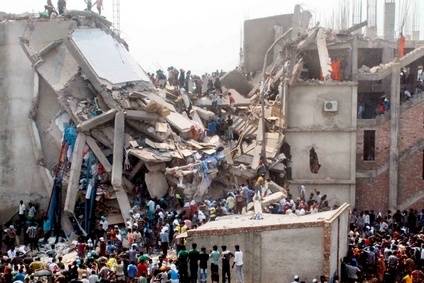
Worker rights group Clean Clothes Campaign is urging the Bangladesh government to stop attempts to expel the Accord, adding it is the only credible instrument preventing factory incidents in the country.
The comments come in the wake of the sixth anniversary of the Rana Plaza building collapse which killed 1,138 garment workers.

Discover B2B Marketing That Performs
Combine business intelligence and editorial excellence to reach engaged professionals across 36 leading media platforms.
The Bangladesh Accord on Fire and Building Safety was set up following the tragedy, and during its five-year tenure inspected more than 1,600 read-made garment factories in Bangladesh on behalf of around 200 global brands and retailers.
The pact expired at the end of last year and the government has been building up its Remediation Coordination Cell (RCC) as the national regulatory body to oversee workplace safety and remediation. But international stakeholders fear the RCC is not yet prepared to take on the responsibilities of the Accord’s inspection programme, despite the government’s claims to the contrary.
The Supreme Court of Bangladesh last week delayed a decision of the future operation of the Accord for an eighth time, with the hearing now set to take place on 19 May.
The CCC is now calling on the Bangladesh government to increase safety efforts for the buildings under its oversight, which include tens of thousands of factories across all industries.

US Tariffs are shifting - will you react or anticipate?
Don’t let policy changes catch you off guard. Stay proactive with real-time data and expert analysis.
By GlobalDataIt says two fires in the last two months – at the FR Tower, which housed several garment brands’ buyers offices, and the Anzir Apparels factory – resulted in 95 deaths, which could have been prevented as the buildings were within the monitoring scope of the government.
“The safety crisis is indisputable. An investigation by the Bangladesh Fire Service and Civil Defence showed 97% of the 3,786 buildings surveyed in Dhaka to be ‘risky’ or ‘extremely risky'” it adds.
The worker rights group also says the new Nirapon Bangladesh factory safety scheme launched last month and backed by former Alliance for Bangladesh Worker Safety brands, is “grossly inadequate” since it is not a regulatory agency that can require remediation in factories, nor does it publicly identify factories that fail to meet standards.
“The Accord remains the only credible instrument preventing factory incidents in a country where the government’s inspection agencies do not yet have the capacity or willingness to enforce safety measures,” says Linda Yanz of the Maquila Solidarity Network.
“Fortunately, apparel companies continue to recognise this, with two new brands signing onto the agreement last week. Companies that source from Bangladesh and think that less transparent or non-binding alternatives might provide the same level of protection for their workers, and brand reputation, risk seeing tragedy strike again in their supplier factories.”
“Locally sustainable culture of safety”
However, Nirapon’s CEO Moushumi Khan has insisted to just-style that the programme is helping to create a “locally sustainable culture of safety” and that “multiple brands aligning behind one initiative and accepting one safety inspection is an effective way forward.”
“Nirapon’s sole focus is safety monitoring and maintaining the compliance progress of the last five years through inspection reporting and building local capacity,” he says.
“Our process of vetting, testing and training Qualified Assessment Firms of engineers and Local Training Providers who will independently verify the safety compliance of factories and assess their worker training programmes, with final confirmations by Nirapon, furthers this transition to a locally sustainable culture of safety.
“All the impact data of the Alliance remediation efforts is available for public information. Nirapon is not a remediating organisation, but a monitoring and brand reporting one.
“The vast majority of Alliance member factories have met their corrective action or remediation plans, allowing this transition to a monitoring model to build on this achievement as a starting point for Nirapon’s mission. There have been zero deaths from fire, structural or electrical incidents in these factories. Like the Alliance before it, and because of our shared objective of keeping workers safe, Nirapon continues to cooperate and support the work of the Accord and all other stakeholders sharing this goal.”





